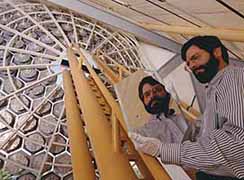| . |  |
. |
 Huntsville - October 13, 1999 - Telescopes with the power to view Earth-like planets in distant solar systems have so far existed only in "star-gazers'" dreams. Now, after several years in the making, efforts to make large-scale space optics a reality are being led by a new technology center at the Marshall Space Flight Center in Huntsville, Ala.
Huntsville - October 13, 1999 - Telescopes with the power to view Earth-like planets in distant solar systems have so far existed only in "star-gazers'" dreams. Now, after several years in the making, efforts to make large-scale space optics a reality are being led by a new technology center at the Marshall Space Flight Center in Huntsville, Ala.NASA's Space Optics Manufacturing Center unites into one organization groups working to expand our view of the universe via sophisticated new telescopes. "The optics center's goal is to develop low-cost, advanced space optics technologies for NASA programs in the 21st century -- including the long-term goal of imaging Earth-like planets in distant solar systems," said Dr. Scott Smith, director of the new Space Optics Center. "This will require advances in large-optics technology previously considered beyond the realm of imagination. Improving optics manufacturing methods is a critical step in this process, said Smith. "NASA's goal is to advance space optical system research while lowering costs." Advanced optics missions are nothing new for Marshall. The Center developed several of the world's largest space-based observatories for NASA: Skylab's Apollo Telescope Mount launched in the early '70s; the High-Energy Astrophysics Observatory series launched in the late '70s, the Hubble Space Telescope launched in 1990, and most recently, the Chandra X-ray Observatory. In August, Chandra started transmitting unprecedented X-ray images from space. "The mirrors for the Chandra telescope were custom-made one at a time," Smith said. "Now at Marshall, we have developed a replication process that allows us to make 70 mirrors for about the price of a single mirror used on earlier telescopes." Replication uses reusable forms, called mandrels, to make telescope mirrors that require no final finishing. Without replication, producing a single large X-ray mirror can cost tens of millions of dollars. The replicated mirrors are being developed for potential use in Constellation-X, a space telescope program led by NASA's Goddard Space Flight Center in Greenbelt, Md. "Constellation-X will have 70 mirror sets on each of its four telescopes for a total of 280 mirror sets," Smith said. "When you compare this to the four mirror sets used on Chandra, you can see the importance of streamlining the manufacturing process." By leading optics technology development, the Marshall Center is also supporting Goddard in developing the Next Generation Space Telescope. As part of this effort, it is sponsoring unprecedented work in the private sector to create ultra-lightweight optics for this and future optics missions. Currently, mirrors are under development that would be 10 times lighter than the Hubble Space telescope mirror while having an equal light-collecting area. These mirrors are scheduled for testing in the Marshall cryogenic optical test facility this coming winter. Even lighter-weight mirrors are envisioned for future missions, pushing the weight per unit area down by a factor of 100 from Hubble. Weighing less than one ounce per square foot (0.1 kilograms per square meter), these new mirrors would be almost as lightweight as clear plastic wrap. The optics center's capabilities include optical fabrication, accurate surface measurements, optics testing and diamond turning, a high-precision process using diamond-tipped tools to cut metal. The Space Optics Manufacturing Center is working to create governmental, industrial and educational partnerships to share technology, facilities and ideas. "By bringing these organizations together, we're uniting pockets of expertise," Smith said. "There's strength in mutual interests." For example, the new center is developing the world's industrial standards for large optical metrology under an agreement with the U.S. Department of Commerce's National Institute of Standards and Technology. It also will serve as a national center for large-size optical processing technology.
SpaceScope News at SpaceDaily
|
| |||||||||
| The content herein, unless otherwise known to be public domain, are Copyright 1995-2016 - Space Media Network. All websites are published in Australia and are solely subject to Australian law and governed by Fair Use principals for news reporting and research purposes. AFP, UPI and IANS news wire stories are copyright Agence France-Presse, United Press International and Indo-Asia News Service. ESA news reports are copyright European Space Agency. All NASA sourced material is public domain. Additional copyrights may apply in whole or part to other bona fide parties. Advertising does not imply endorsement, agreement or approval of any opinions, statements or information provided by Space Media Network on any Web page published or hosted by Space Media Network. Privacy Statement All images and articles appearing on Space Media Network have been edited or digitally altered in some way. Any requests to remove copyright material will be acted upon in a timely and appropriate manner. Any attempt to extort money from Space Media Network will be ignored and reported to Australian Law Enforcement Agencies as a potential case of financial fraud involving the use of a telephonic carriage device or postal service. |